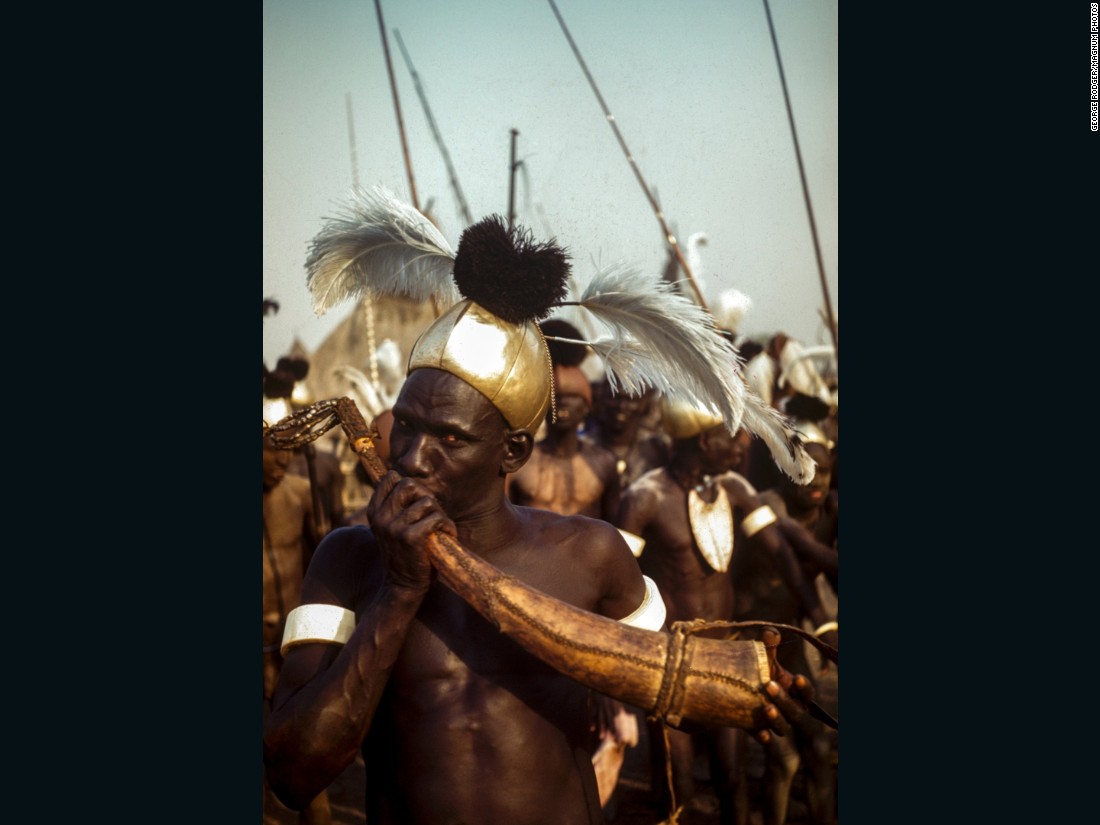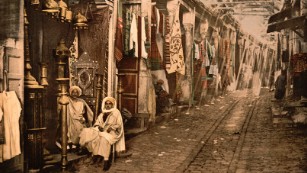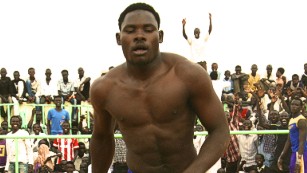"Lost" early photos shed light on Sudan's Nuba and Latuka tribes

In 1948 and 1949 recent war picture taker George Rodger dared to southern Sudan as the principal Westerner formally allowed to photo the people groups of the Nuba mountains. While Rodger's highly contrasting pictures picked up popularity - and propelled movie producer and one-time Nazi promulgation creator Leni Riefenstahl to visit in the 70s - his shading photos, shot on a Leica with Kodachrome film, stayed unpublished as of not long ago.
Imagined: Latuka move of the rainmakers, 1948. A warrior sounds the local horn called the namogo, which is the finish of an elephant's tusk secured with the uncut extended skin of a bull tail.
Shroud Caption
1 of 9
Wrist trinket contenders of the Kao-Nyaro, 1949. Made of metal and weighing up to about five pounds, they could split a man's skull.
Photographs: Sudan's Nuba and Latuka people groups, c.1948-9
Wrist trinket contenders of the Kao-Nyaro, 1949. Made of metal and weighing up to about five pounds, they could split a man's skull.
Conceal Caption
2 of 9
Kao-Nyaro warriors, 1949. The Kordofan area at the time was unmistakably not quite the same as the northern scopes of the nation, which was led by the British. The north had a principally Arabic culture, while the home of the Kao-Nyaro kept up its Sub-Saharan roots.

Photographs: Sudan's Nuba and Latuka people groups, c.1948-9
Kao-Nyaro contenders, 1949. The Kordofan locale at the time was unmistakably not the same as the northern scopes of the nation, which was administered by the British. The north had a fundamentally Arabic culture, while the home of the Kao-Nyaro kept up its Sub-Saharan roots.
Shroud Caption
3 of 9
Wrestlers of the Kao-Nyaro, 1949. The game is a wellspring of pride and profoundly focused, and has been rehearsed for centuries. Wrestlers cover themselves in wood fiery debris and catch, the point being to put your rival on the ground.
Photographs: Sudan's Nuba and Latuka people groups, c.1948-9
Wrestlers of the Kao-Nyaro, 1949. The game is a wellspring of pride and profoundly focused, and has been rehearsed for centuries. Wrestlers cover themselves in wood fiery debris and catch, the point being to put your rival on the ground.
Shroud Caption
4 of 9
Korongo Nuba wrestlers hold up to contend under the shade of a boabab tree, 1949.
Photographs: Sudan's Nuba and Latuka people groups, c.1948-9
Korongo Nuba wrestlers hold up to contend under the shade of a boabab tree, 1949.
Conceal Caption
5 of 9
The tribal wrestling challenges of days past have since developed, with Nuba wrestling now a noteworthy fascination, filling stadiums. Bookmakers can make their fortunes from nearby champions, and the champions themselves frequently have <a href="http://edition.cnn.com/2015/09/01/brandish/nuba-wrestling-olympics-2020/">Olympic ambitions</a>.
Photographs: Sudan's Nuba and Latuka people groups, c.1948-9
The tribal wrestling challenges of days past have since advanced, with Nuba wrestling now a noteworthy fascination, filling stadiums. Bookmakers can make their fortunes from neighborhood champions, and the champions themselves regularly have Olympic aspirations.

Shroud Caption
6 of 9
In Korongo Nuba wrestling, the champion is carried on the shoulders of the crushed party in what's known as "the leading of the victor."
Photographs: Sudan's Nuba and Latuka people groups, c.1948-9
In Korongo Nuba wrestling, the champion is carried on the shoulders of the crushed party in what's known as "the leading of the victor."
Shroud Caption
7 of 9
Latuka individuals play out a rain move, 1948. The yearly occasion happens to convey fortunes to the reap and closures with a creature relinquish. The extent of the creature, gotten by Moyimiji warriors, corresponds to the span of the collect - so the bigger the monster the better. <br/><br/>
Photographs: Sudan's Nuba and Latuka people groups, c.1948-9
Latuka individuals play out a rain move, 1948. The yearly occasion happens to convey fortunes to the reap and closures with a creature give up. The extent of the creature, gotten by Moyimiji warriors, corresponds to the span of the gather - so the bigger the brute the better.
Conceal Caption
8 of 9
Youthful Latuka warriors sit tight for the service to begin,1948.
Photographs: Sudan's Nuba and Latuka people groups, c.1948-9
Youthful Latuka warriors sit tight for the service to begin,1948.
Conceal Caption
9 of 9
In 1948 and 1949 recent war picture taker George Rodger dared to southern Sudan as the principal Westerner authoritatively allowed to photo the people groups of the Nuba mountains. While Rodger's high contrast pictures picked up acclaim - and enlivened producer and one-time Nazi purposeful publicity creator Leni Riefenstahl to visit in the 70s - his shading photos, shot on a Leica with Kodachrome film, stayed unpublished until now.<br/><br/>Pictured: Latuka move of the rainmakers, 1948. A warrior sounds the local horn called the namogo, which is the finish of an elephant's tusk secured with the uncut extended skin of a bull tail.
Photographs: Sudan's Nuba and Latuka people groups, c.1948-9
In 1948 and 1949 past war picture taker George Rodger dared to southern Sudan as the main Westerner authoritatively allowed to photo the people groups of the Nuba mountains. While Rodger's high contrast pictures picked up acclaim - and roused movie producer and one-time Nazi purposeful publicity creator Leni Riefenstahl to visit in the 70s - his shading photos, shot on a Leica with Kodachrome film, stayed unpublished up to this point.
Imagined: Latuka move of the rainmakers, 1948. A warrior sounds the local horn called the namogo, which is the finish of an elephant's tusk secured with the uncut extended skin of a bull tail.
Shroud Caption
1 of 9
Wrist trinket warriors of the Kao-Nyaro, 1949. Made of metal and weighing up to almost five pounds, they could break a man's skull.
Photographs: Sudan's Nuba and Latuka people groups, c.1948-9
Wrist trinket contenders of the Kao-Nyaro, 1949. Made of metal and weighing up to about five pounds, they could break a man's skull.
Shroud Caption
2 of 9
Kao-Nyaro contenders, 1949. The Kordofan district at the time was particularly unique in relation to the northern compasses of the nation, which was managed by the British. The north had a basically Arabic culture, while the home of the Kao-Nyaro kept up its Sub-Saharan roots.
Photographs: Sudan's Nuba and Latuka people groups, c.1948-9
Kao-Nyaro contenders, 1949. The Kordofan locale at the time was unmistakably not the same as the northern spans of the nation, which was controlled by the British. The north had a basically Arabic culture, while the home of the Kao-Nyaro kept up its Sub-Saharan roots.
Shroud Caption
3 of 9
Wrestlers of the Kao-Nyaro, 1949. The game is a wellspring of pride and profoundly aggressive, and has been polished for centuries. Wrestlers cover themselves in wood cinder and catch, the point being to put your rival on the ground.
Photographs: Sudan's Nuba and Latuka people groups, c.1948-9
Wrestlers of the Kao-Nyaro, 1949. The game is a wellspring of pride and exceedingly aggressive, and has been honed for centuries. Wrestlers cover themselves in wood slag and catch, the point being to put your rival on the ground.
Conceal Caption
4 of 9
Korongo Nuba wrestlers hold up to contend under the shade of a boabab tree, 1949.
Photographs: Sudan's Nuba and Latuka people groups, c.1948-9
Korongo Nuba wrestlers hold up to contend under the shade of a boabab tree, 1949.
Conceal Caption
5 of 9
Confined George Rodger Nuba and Latuka 5RESTRICTED George Rodger Nuba and Latuka 2RESTRICTED George Rodger Nuba and Latuka 8RESTRICTED George Rodger Nuba and Latuka 1RESTRICTED George Rodger Nuba and Latuka 7RESTRICTED George Rodger Nuba and Latuka 4RESTRICTED George Rodger Nuba and Latuka 3RESTRICTED George Rodger Nuba and Latuka 6RESTRICTED George Rodger Nuba and Latuka 9
Aaron Schulman is an American picture taker, author and editorial manager. The accompanying is an altered concentrate from his article "The Color Photographs by George Rodger" in "Nuba and Latuka: The Color Photographs" by George Rodger, distributed by Prestel.
(CNN)It is entrenched that the delightful and dumbfounding highly contrasting photos made by George Rodger in 1948 and 1949 - most broadly of the indigenous individuals of the Nuba mountains, in the previous focal Sudanese area of Kordofan, and the Latuka and different tribes of southern Sudan - are probably the most generally imperative and compelling pictures taken in sub-Saharan Africa amid the twentieth century.
Uncommon shading pictures from 1899 offer look into a lost North Africa
Uncommon shading pictures from 1899 offer look into a lost North Africa
Not exclusively do they speak to a variety of tribes who were completely one of a kind and enduringly customary as far as their traditions, ensembles, engineering, farming, ceremonies and get-togethers, they additionally record these tribes' initially approved experience with a Western picture taker, as Rodger was allowed official authorization to photo there by the Sudanese government itself.
Obviously, Rodger was truly captivated by the general population and societies he experienced, yet as an establishing individual from the recently settled Magnum Photos and a dynamic supporter of the quickly growing global broad communications at the time, he was likewise resolved to completely pass on and share his encounters of the Nuba with whatever is left of the world by means of the then predominant medium of photography.
Among a wide assortment of understandings, the photo can - and frequently has - been too effortlessly misinterpreted as one arranged inside the longstanding pilgrim convention of speaking to the general population of Africa as "respectable savages," as examples of a "primitive" humankind untouched by "development."
However, it is essential to perceive that straightforwardly preceding shooting the Nuba people groups, Rodger had spent the earlier decade - from 1939 to 1947 - as a Second World War reporter for Life magazine. In that time, he had secured the passing and obliteration experienced amid the London Blitz, the fierceness of the Burma battle, the Allies' rough advance through Italy





No comments